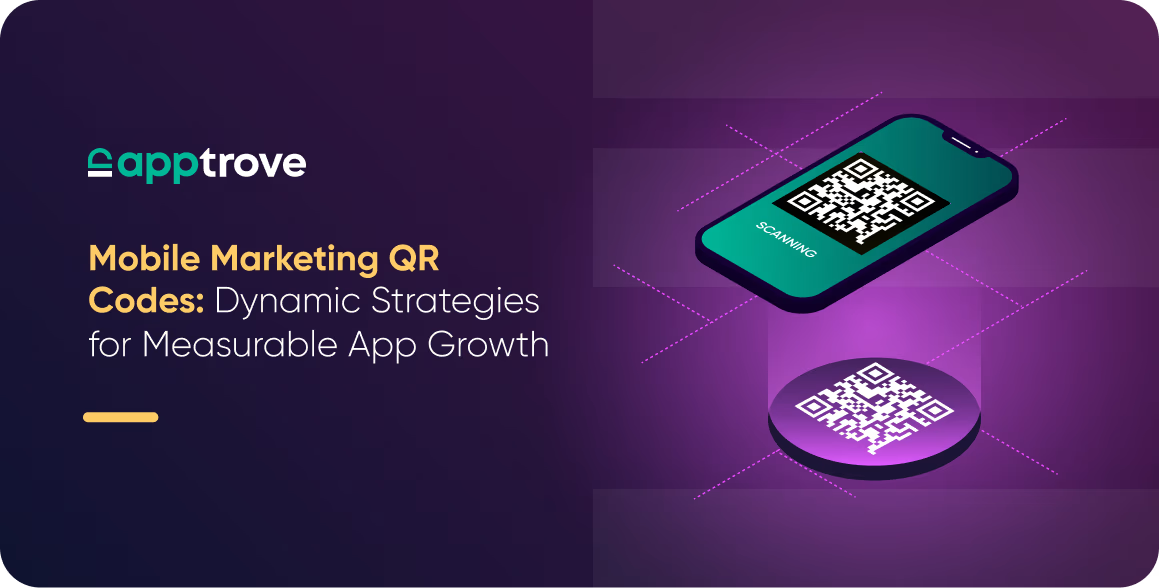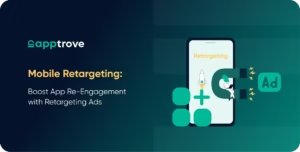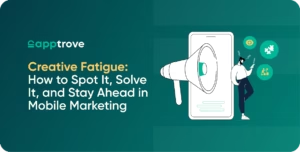Marketers are forever looking to leverage the lucrative opportunities in the ever-expanding mobile industry. The mobile ad spending is expected to surpass $235.7 billion by 2025 growing at a CAGR of 12% (between 2022 and 2025).
However, the unprecedented growth and intense competition make it tough for marketers to navigate the ins and outs of mobile ads. Hence, this post will equip you to create a strong mobile advertising strategy with Apptrove.
What is Mobile Advertising?
In mobile advertising, marketers display advertisements on phones and tablets using paid channels. It is an effective method to reach the target audience and persuade them to decide.
When talking about advertising on mobile, there are two stakeholders you should be aware of:
- Brand/Advertiser: Refers to the brand looking to advertise its products or services.
- Publishers: Refers to the platform on which the advertisement will be displayed for the relevant audiences
Besides, you should know about ad networks, agencies, and ad exchanges.
Ad networks connect brands and publishers and hold the advertising inventory.
Agencies liaison between the brands and ad networks to facilitate the mobile advertising process.
Ad exchanges are like ad networks but help brands automate the process of buying and selling ads programmatically.
Advantages of Mobile Advertising
Increased Reach
Mobile advertisements allow marketers to access a huge pool of over 4.8 billion people who use smartphones to research a product.
Precise Targeting
Mobile app advertising offers detailed insights from various data points about the target audience, allowing marketers to optimize their marketing efforts. They can learn about mobile connections, user interests, location, habits, spending patterns, and more.
Cost Effectiveness
The cost-effectiveness of mobile ads strategy allows marketers to enjoy a high ROAS with improved conversion rates and low advertising costs.
Right Place at the Right Time
With mobile ads, brands leverage geolocation to present users with relevant product offers and advertisements, which increases the chances of a conversion.
Challenges of Mobile Advertising
Fraud Risks
One of the biggest challenges for mobile marketers today is the growing prevalence of mobile ad fraud. It could be fake installs, install hijacking, bots, or even device farms, depending on the vulnerabilities bad actors exploit. Hence, app marketers must find accurate ways to detect and prevent fraud.
Increased Privacy Frameworks
Stringent privacy frameworks have made advertising to mobile users challenging. Google has been moving towards a cookie-less browser experience, and Apple has introduced the ATT framework, making it difficult for advertisers to access customer data like before.
Mobile marketers can consider alternative approaches, such as cohort analysis and predictive modeling to get around this challenge.
Types of Mobile Ads
Here are some of the primary types of mobile ads you should be aware of –
- Mobile Display Ads: These are the most common mobile ads types that appear as banners on top or bottom of the screen. They could be images, videos, and even rich media elements.
- Video Ads: Video ads including audio and video elements are quite common when discussing mobile ad formats. However, even these ads can come in multiple forms such as skippable and unskippable in-stream, in-feed videos, masthead ads, and bumpers.
- Interstitial Ads: These mobile ads appear between breaks or transitions and take up the entire screen – very commonly displayed in gaming apps and websites.
- Native Ads: Mobile ads that mimic the look and feel of an app or website so that they do not stand out, are known as native ads.
In-App Ads: In-app advertisements refer to displaying ads to users of an app while they are using it, thus ensuring that their user experience is not disrupted. - AR Ads: Augmented Reality ads provide a more immersive experience to users encouraging users to interact with or test out the promoted products.
Building a Robust Mobile Advertising Strategy
Let’s get to creating a mobile performance advertising strategy that works for you.
Ensure the Ad Aligns with the Target Audience
One of the most crucial parts of a mobile ads strategy is getting to know the target audience. Even the most basic demographic data about customers such as their gender, employment status, location, and income can be crucial parts of the puzzle.
As a publisher, you can use this data to narrow down the target audience and display highly laser-focused and tailored ads on your app. Most ad networks let brands curate mobile advertising campaigns by creating audience segments based on their interests or past interactions with your brand.
Establishing the relevance of an ad with the target audience beforehand improves its engagement rate and performance.
Set SMART Goals and Objectives
Once you have a clear picture of the target audience and their preferences, you can start putting together the advertising strategy.
The first step in this process is setting appropriate goals and objectives that will help you determine whether an ad is right for your app user base. Setting SMART goals and objectives goes a long way in this process.
Here are a few clear goal statements:
- Increase app downloads by 15% in 6 months
- Boost brand awareness within X demographic
- Improve customer retention by 10%
Leverage ATT Tracking
Succeeding in the Apple ecosystem means knowing how to leverage ATT tracking properly. While the quality of your ATT prompts determines whether customers will click and opt-in on it, you can ensure that you display the prompt at the right time to stack the odds in your favour.
The more convincing you sound and the more value you offer to users in your ATT prompt, the higher your opt-in rates. So, don’t hesitate to personalize your tracking pitch, and add a design that will help in attracting more users.
Prioritize In-App Performance
Your ad performance when the ads are live can make or break your in-app experience. Even a slight delay can force a user to uninstall your app.
Step up the quality of the ads you display on your app, and ensure that all the technical issues are taken care of. While your front-end user experience is usually to blame for any user abandonment, it almost always highlights an impending issue at the backend. ?
While Improving your app response time, and preventing crashes are good starting points, narrowing down on device performance aspects such as screen rendering times, and energy consumption is important.
Adhere to the Privacy Guidelines
The introduction of the ATT framework by Apple made mobile app marketers’ job more difficult by separating the privacy guidelines associated with the process of attribution for campaigns run on Android and iOS.
While the new privacy guidelines do complicate the process of attribution for marketers, having the right MMP will help you adhere to them and assure your users of their data privacy simultaneously.
For instance, our platform has multiple privacy certifications such as GDPR, CCPA, and ePrivacy that can help you ensure that your mobile app is never in violation of any privacy guidelines.
Implement Reporting and Documentation
The best way to ensure that your mobile app is always on top of its advertising strategy is by ensuring consistency. Consistency eliminates actions that have not worked for your app in the past, and has multiple iterations of actions that have been effective.
Of course, the decision to repeat or eliminate an action is made with the help of relevant data and analytics. Leverage an MMP to get data-driven insights into what is working in your advertising campaigns and document them in the form of periodic performance reports.
Besides, you need to keep a close eye on the top metrics that measure the success of your campaigns.
- Conversion rate
- Cost per click (CPC)
- Cost per action (CPA)
- Cost per install (CPI)
- Retention Rate
- Lifetime Value (LTV)
- Return on Ad Spend (ROAS)
Learn more about the key mobile app metrics in our detailed post on the subject.
Utilize Tools to Monitor Mobile Advertising Performance
An effective MMP will help you measure the performance of your mobile marketing and advertising campaigns across channels, media sources, and ad networks. More specifically, MMPs offer a goldmine of data for mobile attribution to attribute each conversion to the right source.
MMPs track the mobile advertising campaign performance, optimize it, and scale up your campaigns with the help of data-driven insights.
Here are some of the features Apptrove offers to help you make an informed decision:
Granular Audience Segmentation
Gain superior link intelligence and get real-time insights into how users interact with the ad. Apptrove’s granular filters help you segment your user base according to their app behavior, purchase intent, and preferred communication mode.
With the help of such tailored audience segments, you can create contextual experiences that will drive more lifetime value and narrow down on the most valuable cohorts – not compromising data privacy.


Deep Linking
One of the best features provided by Apptrove is the ability for brands to create branded Unilinks to unify customer journeys. You can create dynamic deep links for every campaign and partner and implement anti-fraud settings on each link to ensure the security of your ROI.
What’s more, the deep linking suite offered by Apptrove ensures that you offer seamless customer experiences while keeping your focus firmly on ROAS.
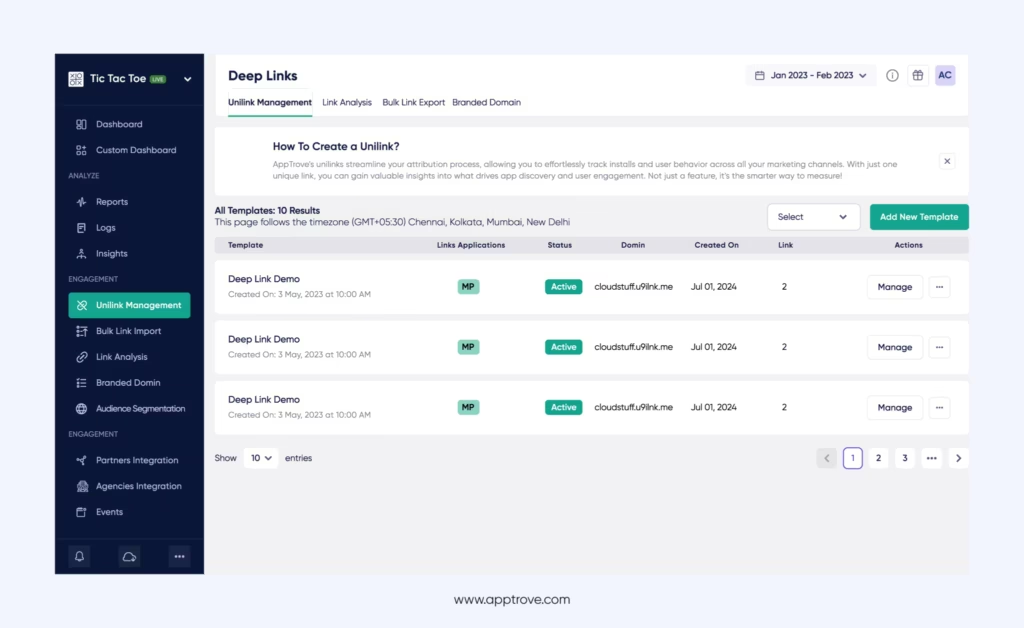
Dedicated Customer Support
Starting from day zero, the Apptrove team assists you with everything – from onboarding to ongoing support over time. Our personalized onboarding makes it all about you. We have dedicated customer success managers, account managers, and tech specialists who strive to make your campaign a success.
You can get in touch with customer support through emails, Skype, direct phone calls, or even using the ticket management system on the website.
Anti-Fraud Protection
Apptrove offers features to prevent any kind of fraud that drains your campaign ROI. With the help of custom fraud shields, you can create a comprehensive fraud prevention strategy with custom rules for each campaign or partner.
You can also validate each conversion with the help of specific KPIs to ensure authenticity, and protect your ad spend with multilayer fraud protection against a vast range of threats. Moreover, you can set validation rules and manage them from a single dashboard.
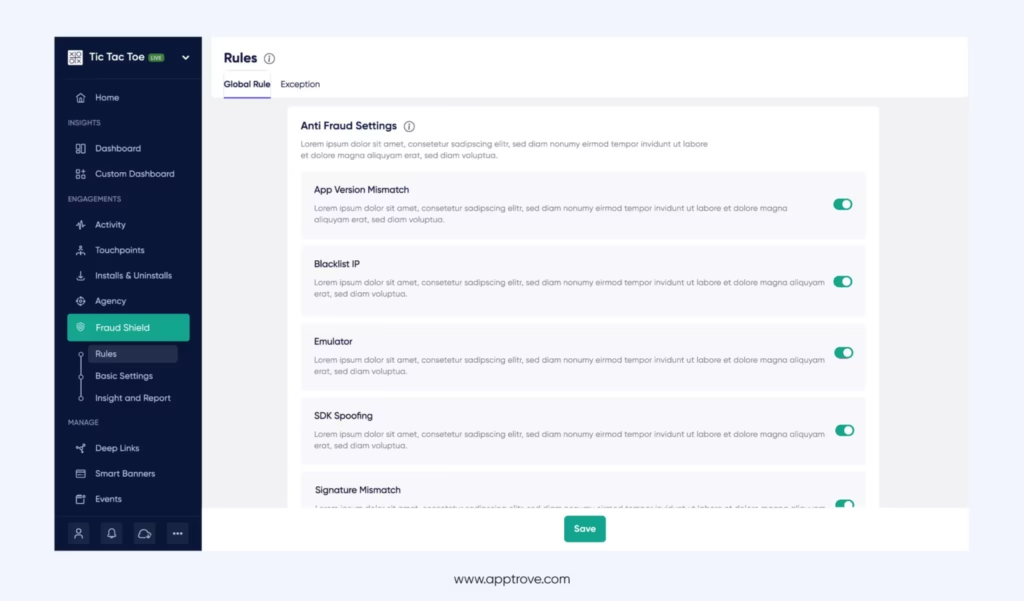
Adherence to Privacy Regulations
With Apptrove, you can be assured that all your data is safeguarded by advanced privacy measures. With the help of regular security audits and penetration testing, you can identify and correct any vulnerabilities before they impact the campaign outcomes.
The Apptrove platform also uses AES256 encryption that protects critical information and a disaster recovery protocol. Moreover, Apptrove has privacy certifications such as ISO 27001, GDPR, ePrivacy, and CCPA that ensure adherence to privacy regulations at various geographical locations.
Summing Up
With the help of mobile advertising, mobile marketers can aim for better reach, cost-effectiveness, and even precise targeting of their users. Once you have a mobile advertising strategy in place, make sure you track the relevant metrics using sophisticated and technologically advanced tools.
Apptrove is a mobile measurement partner that lets you attribute the success and failure of your campaign to the right sources. It also takes a data-driven approach to mobile attribution and has anti-fraud mechanisms built into every step of the process.
Get in touch with our team to start tracking your advertising campaigns effectively.
FAQs
1. Why is mobile advertising important in 2025?
Mobile advertising is crucial in 2025 because over 4.8 billion people use smartphones to research, shop, and engage with brands. With ad spending projected to surpass $235.7 billion, mobile ads allow brands to reach users at scale with precision targeting, cost efficiency, and real-time engagement.
2. What are the main challenges of mobile advertising today?
Some of the biggest challenges include mobile ad fraud (fake installs, bots, install hijacking), stricter privacy regulations like Apple’s ATT framework and Google’s cookie-less move, and ensuring seamless ad performance within apps. Marketers must balance user experience, data privacy, and ROI protection.
3. What types of mobile ads work best for brands?
The effectiveness depends on your goals, but popular mobile ad formats include:
1. Video ads for engagement and storytelling.
2. Native ads for blending with the user experience.
3. In-app ads for targeted, non-disruptive promotion.
4. AR ads for interactive product experiences.
Choosing the right mix ensures better reach and conversions.
4. How can marketers measure mobile advertising success?
Success is measured through performance metrics such as:
1. Conversion Rate
2. Cost per Click (CPC)
3. Cost per Install (CPI)
4. Customer Retention Rate
5. Lifetime Value (LTV)
6. Return on Ad Spend (ROAS)
Using an MMP like Apptrove helps attribute conversions correctly and optimize campaigns with accurate, data-driven insights.
5. How does Apptrove help improve mobile advertising ROI?
Apptrove enhances ROI by offering:
1. Deep Linking (Unilinks): Seamless user journeys from ad click to in-app experience.
2. Anti-Fraud Protection: Shields against bots, fake installs, and hijacking.
3. Audience Segmentation: Tailored cohorts for precise targeting.
4. Privacy Compliance: GDPR & CCPA certifications.
5. Advanced Analytics: Real-time reporting to scale campaigns effectively.



